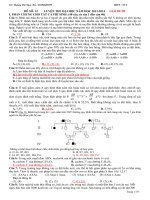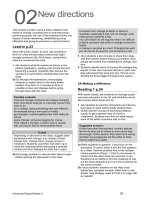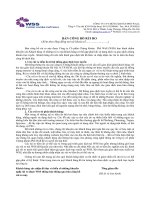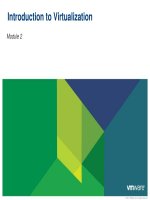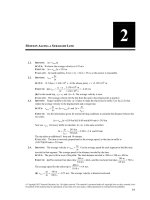VSICM6 m02 virtualizationintro
Bạn đang xem bản rút gọn của tài liệu. Xem và tải ngay bản đầy đủ của tài liệu tại đây (1.78 MB, 48 trang )
Software-Defined Data Center
Module 2
© 2015 VMware Inc. All rights reserved.
You Are Here
9.
7.
Virtual Machine Management
10. Software-Defined Data Center
8.
Resource Management and Monitoring
11.
9.
vSphere HA and vSphere Fault Tolerance
Course Introduction
Creating Virtual Machines
12. vCenter Server
10. Host Scalability
13. Configuring and Managing Virtual Networks
11.
14. Configuring and Managing Virtual Storage
12. Installing vSphere Components
vSphere Update Manager and Host Maintenance
VMware vSphere: Install, Configure, Manage
© 2015 VMware Inc. All rights reserved.
2-2
Importance
VMware vSphere® is based (dựa trên) on many components (lựa chọn) with which a vSphere administrator should be
familiar. You must understand the following concepts (khái niệm) and best practices:
•
Virtualization, VMware ESXi™, and the virtual machine
•
The fundamental vSphere components and how vSphere can be used in the software-defined data center
•
How VMware vSphere® Client™ and VMware vSphere® Web Client are used to administer and manage vSphere
environments
VMware vSphere: Install, Configure, Manage
© 2015 VMware Inc. All rights reserved.
2-3
Module Lessons
Lesson 1:
Introduction to the Software-Defined Data Center
Lesson 2:
vSphere Client
Lesson 3:
Overview of ESXi
VMware vSphere: Install, Configure, Manage
© 2015 VMware Inc. All rights reserved.
2-4
Lesson 1:
Introduction to the Software-Defined Data Center
2-5
© 2015 VMware Inc. All rights reserved.
Learner Objectives
By the end of this lesson, you should be able to meet the following objectives:
•
Compare and contrast physical and virtual architectures
•
Describe the benefits of using virtual machines
•
Describe how vSphere interacts with CPUs, memory, networks, and storage
•
Describe how vSphere fits into the cloud and the software-defined data center
VMware vSphere: Install, Configure, Manage
© 2015 VMware Inc. All rights reserved.
2-6
Topology of a Physical Data Center
Administering and maintaining a physical data center is time consuming and often inefficient.
Applications
Operating System
Physical Host
Fibre
Ethernet
Channel
FCoE
Storage
iSCSI
NFS
Local Area
Fibre Channel
Storage
Storage
Network
Storage
VMware vSphere: Install, Configure, Manage
© 2015 VMware Inc. All rights reserved.
2-7
Introducing the Virtual Infrastructure
Virtualization enables you to run more workloads on a single server by consolidating the environment so that your
applications run on virtual machines.
Virtual
Machines
Hypervisor
ESXi Host
Fibre
Ethernet
Channel
FCoE
Storage
iSCSI Storage
NFS Storage
Local Area
Fibre Channel Storage
Network
VMware vSphere: Install, Configure, Manage
© 2015 VMware Inc. All rights reserved.
2-8
About Virtual Machines
A virtual machine is a software computer that, like a physical computer, runs an operating system and applications.
Virtual Machine
Virtual Machine Components
•
Operating system
•
VMware Tools™
•
Virtual resources such as:
–
CPU and memory
–
Network adapters
–
Disk controllers
–
Parallel and serial ports
VMware vSphere: Install, Configure, Manage
© 2015 VMware Inc. All rights reserved.
2-9
Benefits of Using Virtual Machines
Physical Machines
Virtual Machines
Difficult to relocate:
Easy to relocate:
•
Moves require downtime.
•
Encapsulated into files.
•
Specific to physical hardware.
•
Independent of physical hardware.
Difficult to manage:
Easy to manage:
•
Require physical maintenance.
•
Isolated from other virtual machines.
•
Hardware failures cause downtime.
•
Insulated from hardware changes.
Hardware has limitations:
Provide the ability to support legacy applications.
•
Hardware changes limit application support.
Enable servers to be consolidated.
•
One-to-one relationship between application and server.
VMware vSphere: Install, Configure, Manage
© 2015 VMware Inc. All rights reserved.
2-10
Physical Architecture and Virtual Architecture
Virtualization is a technology that decouples physical hardware from a computer operating system and provides a solution to
many of the problems that IT staff face.
Physical Architecture
Virtual Architecture
Application
Operating System
x64 Architecture
vSphere
x64 Architecture
VMware vSphere: Install, Configure, Manage
© 2015 VMware Inc. All rights reserved.
2-11
Physical Resource Sharing
Virtual Resources
vSphere
x64
Architecture
Physical Resources
VMware vSphere: Install, Configure, Manage
© 2015 VMware Inc. All rights reserved.
2-12
CPU Virtualization
In a physical environment, the operating system assumes the ownership of all the physical CPUs in the system.
CPU virtualization emphasizes performance and runs directly on the available CPUs.
Physical Architecture
Virtual Architecture
Application
Operating System
vSphere
x64 Architecture
x64 Architecture
VMware vSphere: Install, Configure, Manage
© 2015 VMware Inc. All rights reserved.
2-13
Physical and Virtualized Host Memory Usage
In a physical environment, the operating system assumes the ownership of all physical memory in the system.
Memory virtualization emphasizes performance and runs directly on the available RAM.
Physical Architecture
Virtual Architecture
Application
1 GB
2 GB
Operating System
vSphere
x64 Architecture
x64 Architecture
VMware vSphere: Install, Configure, Manage
© 2015 VMware Inc. All rights reserved.
8 GB
2-14
Physical and Virtual Networking
Virtual Ethernet adapters and virtual switches are key virtual networking components.
Physical Architecture
Virtual Architecture
Application
Operating System
Virtual Switch
x64 Architecture
vSphere
x64 Architecture
VMware vSphere: Install, Configure, Manage
© 2015 VMware Inc. All rights reserved.
2-15
Physical File Systems and VMFS
VMware vSphere® VMFS enables a distributed storage architecture, allowing multiple ESXi hosts to read or write to the
shared storage concurrently.
Physical Architecture
Virtual Architecture
Application
Operating System
vSphere
vSphere
x64 Architecture
x64 Architecture
x64 Architecture
Shared Storage: VMFS, NFS, Virtual SAN
NTFS, ext4, UFS
VMware vSphere: Install, Configure, Manage
© 2015 VMware Inc. All rights reserved.
2-16
Encapsulation
VM 1
Virtual machine files are stored in directories on a VMFS or NFS datastore.
VM 2
VM 3
Datastore: VMFS or NFS
VMware vSphere: Install, Configure, Manage
© 2015 VMware Inc. All rights reserved.
2-17
About the Software-Defined Data Center
In a software-defined data center, all infrastructure is virtualized, and the control of the data center is entirely automated by
software.
Software-Defined Data Center
Policy-Based Management and Automation
Cloud Automation
Cloud Operations
Cloud Business
Virtualized Infrastructure
Hybrid Cloud
Abstract and Pool
VMware and
vCloud Air Data Center Partners
Compute Abstraction = Server Virtualization
Network Abstraction = Virtual Networking
Public
Public
Clouds
Clouds
Storage Abstraction = Software-Defined Storage
VMware vSphere: Install, Configure, Manage
© 2015 VMware Inc. All rights reserved.
2-18
How vSphere Fits into Cloud Computing
Cloud computing is an approach that uses the efficient pooling of an on-demand, self-managed, virtual infrastructure.
Private
Hybrid
Hybrid
Cloud
Cloud
Cloud
Public Cloud
VMware vSphere
VMware vSphere: Install, Configure, Manage
© 2015 VMware Inc. All rights reserved.
2-19
About Private Clouds
Private clouds are pools of resources dedicated to a single enterprise.
•
Đám mây riêng là nhóm tài ngun dành riêng cho một doanh nghiệp.
Internet
Advantages: Thuận lợi
Enterprise Private Cloud
Gizmo Division
Widget Division
Human Resources
•
Cung cấp dịch vụ tự phục vụ
•
Tính co giãn của các nguồn lực
•
Cấp phép nhanh chóng và đơn giản hóa
•
nhiều bảo đảm
•
Cải thiện việc sử dụng tài ngun CNTT
•
Kiểm sốt ngân sách CNTT tốt hơn
Sales
VMware vSphere: Install, Configure, Manage
© 2015 VMware Inc. All rights reserved.
2-20
About Public Clouds
In their infrastructure public cloud service, providers host many types of IT operations for multiple businesses.
Advantages:
•
Customer management of IT
•
Rapid and flexible deployments
•
Efficient and cost-effective deployments
•
Secure IT assets
•
Capital expenses converted to operating
Cloud Service Provider
expenses
Company
Company
Company
A
B
C
VMware vSphere: Install, Configure, Manage
© 2015 VMware Inc. All rights reserved.
2-21
About Hybrid Clouds
IT assets are housed both internally on customer premises and in public clouds.
Hybrid
Cloud
App
App
Loads
Loads
App
App
App
Loads
Loads
Loads
Management
Management
Management
Management
Bridge
Bridge
vSphere
vSphere
vSphere
vSphere
Private
Public
Clouds
Clouds
Use Cases
Disaster recovery
Traffic overflow
Quick provisioning
Offsite backup
Data archiving
Development / QA / test
VMware vSphere: Install, Configure, Manage
© 2015 VMware Inc. All rights reserved.
2-22
Review of Learner Objectives
You should be able to meet the following objectives:
•
Compare and contrast physical and virtual architectures
•
Describe the benefits of using virtual machines
•
Describe how vSphere interacts with CPUs, memory, networks, and storage
•
Describe how vSphere fits into the cloud and the software-defined data center
VMware vSphere: Install, Configure, Manage
© 2015 VMware Inc. All rights reserved.
2-23
Lesson 2:
vSphere Client
2-24
© 2015 VMware Inc. All rights reserved.
Learner Objectives
By the end of this lesson, you should be able to meet the following objectives:
•
Identify the user interfaces used with the ESXi host and VMware vCenter Server™
•
Download and install vSphere Client
•
Use vSphere Client to access your ESXi hosts and vCenter Server
VMware vSphere: Install, Configure, Manage
© 2015 VMware Inc. All rights reserved.
2-25


